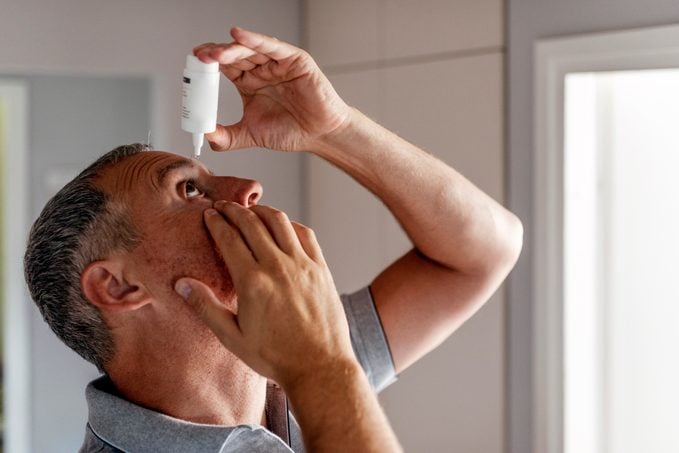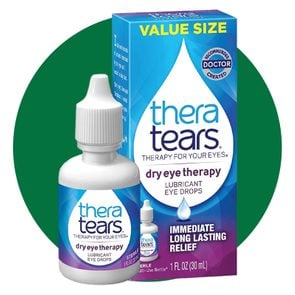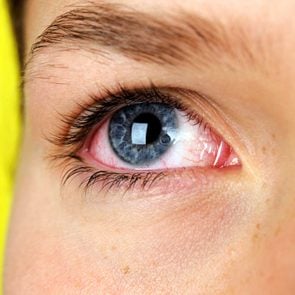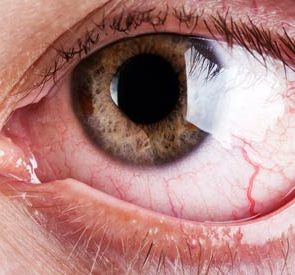6 Home Remedies for Dry Eyes That Doctors Recommend
Updated: Jun. 16, 2021
Get rid of the dryness, redness, and pain that comes with dry eye disease. These simple home treatments, straight from eye specialists, can help you find relief.
Our editors and experts handpick every product we feature. We may earn a commission from your purchases.
Dealing with dry eyes
If you have a healthy abundance of tears, don’t be sad; be grateful that you probably don’t have dry eye disease, also known as keratoconjunctivitis sicca.
But if you do have chronically dry eyes, you’re not alone. A 2017 study published in the American Journal of Ophthalmology found that 6.8 percent of the U.S. adult population, or about 16.4 million people, experience redness, itching, burning, light sensitivity, fluctuating vision, and other symptoms of dry eye disease on a regular basis.
In an ironic twist, people with dry eye disease may even find their eyes watering frequently as a reflexive response to irritation.
Women are nearly twice as likely as men to develop dry eye disease, according to a 2018 article published in Australian Prescriber.
What causes dry eyes?
Eye specialists say there are two broad types of dry eye disease.
One type, called aqueous deficiency, means you don’t produce enough tears. The second type, called evaporative dry eye, occurs when you produce poor-quality tears that evaporate quickly from the surface of the eye.
“There is usually overlap between these two types. Patients can have both,” says Rahul Tonk, MD, an ophthalmologist and specialist in corneal and external disease at the Bascom Palmer Eye Institute at the University of Miami Health System. “At the core, for both of those subtypes, there is inflammation.”
Dry eyes don’t happen only because of a lack of water on the eyes. Part of the reason people experience the condition is that the surface of the eye, which has skin cells just like any other surface of the body, can get stressed out due to environmental or other factors.
Once those cells are stressed, they react as if they were infected—by sending messages telling the immune system to ramp up, Dr. Tonk explains.
Those immune cells, he says, “cause collateral damage,” which produces further inflammation. And that, in turn, results in more stress.
“We call this the vicious cycle of dry eye,” he says. “Dry eye begets dry eye.”
Evaporative dry eye
Evaporative dry eye is far more common and results from a compromised tear film.
“The tear film is a super-complicated structure,” Dr. Tonk says. It has three distinct layers: a saltwater layer, a lipid (or oil) layer, and a mucus layer.
The saltwater layer also contains antibodies and nutrients for the eye, while the mucus layer binds the tear film to the eye, and the oil layer prevents tears from evaporating.
“When that lipid layer is not intact or you don’t have good oil in the tear film, then the rest of the tears—no matter how much you produce—can evaporate,” he says.
The result? Dry, irritated eyes.
In about 85 percent of cases, a blockage or other problem in the meibomian glands, the tiny oil glands at the base of the eyelid, cause this condition, according to the Australian Prescriber study.
Meibomian gland dysfunction, or MGD, is more likely to occur in people who are older, who smoke, or who wear contact lenses. Not blinking enough can also lead to this condition.
Optometrist William T. Reynolds, president of the American Optometric Association in Alexandria, Virginia, says decreased blinking can result from a number of medical conditions, including traumatic brain injury, diabetes, and Parkinson’s disease. It’s also common among people who spend a lot of time looking at computer screens.
Other conditions that can lead to MGD include bacterial overgrowth on the back of the eyelid, overgrowth of mites at the base of the eyelashes (a condition called demodex), and ocular rosacea, which can occur even without facial rosacea, Dr. Tonk says.
Dr. Reynolds notes that people who are frequently exposed to wind, smoke, or dry air (such as firefighters) or people who work around chemicals in agricultural or industrial environments are also at risk for developing evaporative dry eye.
Aqueous deficiency dry eye
This type of dry eye accounts for only 10 percent of cases. Dr. Tonk says it’s usually the result of an autoimmune condition such as rheumatoid arthritis, Sjogren’s disease, or lupus.
These conditions have a secondary effect of destroying the lacrimal glands—the body’s tear-production center.
“The eye is less able to produce its own tears to lubricate itself,” Dr. Tonk says.
It’s also possible to have this condition without autoimmune disease. Certain medications, like antihistamines, decongestants, antidepressants, and blood pressure medications, can reduce tear production, Dr. Reynolds says.
Diagnosing dry eye
The symptoms are nearly identical for both types of dry eye, so you probably won’t figure out which type you have on your own.
“It takes a good eye exam to tell them apart,” Dr. Tonk says, reiterating that most people—he says 80 percent—have some component of both.
During the eye exam, you’ll answer questions about your symptoms and quality of life.
If your eye doctor suspects you have dry eye, you’ll undergo ocular surface staining as part of an initial evaluation, Dr. Reynolds says.
The technique sounds scarier than it is. Your eye doctor will just apply colored eye drops—either fluorescein or lissamine—to the surface of your eye to reveal problems that could cause poor tear production or tear film quality.
Your doctor will perform other tests if symptoms persist, Dr. Reynolds says.

Dry eye treatment
Treatment for dry eye almost always begins with a comprehensive home-care approach, Dr. Tonk says.
Prescription and in-office treatments are also available, but they are usually reserved for more difficult cases that don’t respond to home remedies.
Here are the top home remedies for dry eyes.
Use artificial tears or lubricant eye drops
Dr. Tonk recommends using eye drops labeled “artificial tears” or “lubricant eye drops” during the day, and a thicker lubricating gel at night.
Both are available over the counter (OTC) and should be used on a scheduled basis. He advises avoiding products with chemicals, especially one known as THZ, or tetrahydrozoline. It’s present in eye drops designed to reduce redness but is actually a known eye irritant that can be poisonous if swallowed.
And avoid any formulations with a preservative known as BAK, an acronym for benzalkonium chloride. It’s known to cause damage to the lipid layer of the tear film and, as a result, can both cause and worsen dry eye.
Use lid scrubs or warm compresses to clean eyelids
“We don’t often think of our eyelids as in need of upkeep, but we need to do some kind of basic eyelid hygiene,” Dr. Tonk says, noting that this is especially important for people with evaporative dry eye.
He recommends two OTC components: lid scrubs and warm compresses.
Lid scrubs are detergent-based lid and lash cleansers that help keep bacterial and mite overgrowth at bay.
Warm compresses can melt the meibum and help keep it moving. While a warm washcloth can be used, Dr. Tonk says commercial masks don’t lose their heat as quickly. Good options include the Bruder Moist Heat Eye Compress and Bausch & Lomb’s Thera Pearl eye mask.
“Doing this once or twice daily is helpful,” he says. “It’s like brushing and flossing. If everyone did this as part of their routine, there’d be a lot less dry eye.”
Increase your omega-3 intake
Both Dr. Tonk and Dr. Reynolds recommend adding this nutrient to your diet.
“We have pretty good data that omega-3 fatty acid supplementation is helpful,” Dr. Tonk says. “It’s not only anti-inflammatory, but it also changes the nature of the meibum so it flows easier.”
In fact, a study of 32,000 women published in the American Journal of Clinical Nutrition found that those who had the highest dietary intake of omega-3 from fish had a 17 percent lower risk of dry eye compared with those who ate little or no seafood.
That said, a 2018 study published in The New England Journal of Medicine called the effectiveness of omega-3s into question, finding it no more helpful than an olive oil placebo.
“Notably, both omega-3 and placebo groups had improved signs and symptoms of dry eye,” Dr. Tonk says. “In most cases, the possible benefits of omega-3 supplementation outweigh what small risks they carry.”
While you can get omega-3s from seafood and from plant-based sources, the occasional piece of salmon or fistful of spinach will be insufficient, Dr. Tonk says, and supplements can fill the gap. Look for products with at least one gram of omega-3 fatty acid per dose.
Stop catching air
It’s helpful to avoid anything that blows air toward your face and dries out your eyes, such as ceiling fans, car heaters, and blowdryers. Wrap-around sunglasses can be useful for runners and cyclists.
Another smart move: avoid smoke, and if you smoke, quit.
Just add water
If you live in a dry area, use a humidifier for your home and hydrate your body frequently.
Practice the 20-20-20 rule
If you wear contact lenses, give your eyes a break occasionally and wear your glasses instead. You can also follow the 20-20-20 rule.
“For every 20 minutes of computer use, take 20 seconds to look 20 feet away,” Dr. Tonk advises.
But don’t just stare into the distance during your breaks. Use it to blink your way to less-dry eyes.
“Give yourself a couple of good blinks,” Dr. Tonk says. “Blinking does so much for us. It lets those oils move and allows the eye to nourish itself.”
Next, here’s what you need to know about digital eye strain.



















